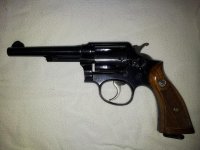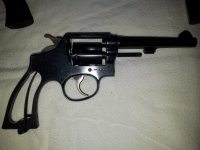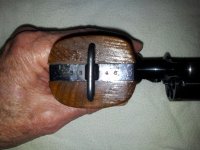CanadianSon
Member
- Joined
- Sep 15, 2015
- Messages
- 5
- Reaction score
- 0
In the late 60's- early 70's the RCMP started swapping out their "long action" revolvers for "short action" versions. Members were allowed to purchase the turned-in revolver right there and then from the storeman by writing a cheque to Crown Assets Disposal ($21.60 in 1971 in this case) and have it federally registered as a restricted private handgun.
This particular model belongs to my father so I would like to know its manufacturing history. Thank you for the detailed sticky instructions on the first page. I will not bother you with the 4 digit number from inside the yoke:
38 S&W Special Cartridge.
5" tapered barrel with the sloped milled front site.
5 screws ( 4 on case and one in front of trigger guard).
An additional strain screw in the hand grip.
No model number or letter for the serial number.
From the butt plate: 6246 plus a stylized stamped "MP".
Lanyard swivel.
From the cylinder face: 629946 (as above but with 99 in the middle). Coincidence?
From the rear of the handgrip: "A.P.P." (possibly Alberta Provincial Police 1917-1932).
From inside the handrip: Another stylized "MP" stamp.
Polished blue/black finish.
The disposal and registration paperwork called it a "Military & Police Model 10 Long Action". I suspect it only had "model 10" added because they closely resembled the newer short action replacements.
The "stylized MP" stamp (the trailing leg of the M serverd as the P) was either from S&W for "Military & Police" or from the RCMP for "Mounted Police". Does this "MP" stamp appear on other standard versions of the "Military&Police" revolver?
The"A.P.P." probably stood for "Alberta Provincial Police" which existed from 1917 to 1932. Then the RCMP took over. That means this revolver was in service before 1933. The stylized MP was probably added by the Mounted Police when they took over the inventory.
Thank you.
This particular model belongs to my father so I would like to know its manufacturing history. Thank you for the detailed sticky instructions on the first page. I will not bother you with the 4 digit number from inside the yoke:
38 S&W Special Cartridge.
5" tapered barrel with the sloped milled front site.
5 screws ( 4 on case and one in front of trigger guard).
An additional strain screw in the hand grip.
No model number or letter for the serial number.
From the butt plate: 6246 plus a stylized stamped "MP".
Lanyard swivel.
From the cylinder face: 629946 (as above but with 99 in the middle). Coincidence?
From the rear of the handgrip: "A.P.P." (possibly Alberta Provincial Police 1917-1932).
From inside the handrip: Another stylized "MP" stamp.
Polished blue/black finish.
The disposal and registration paperwork called it a "Military & Police Model 10 Long Action". I suspect it only had "model 10" added because they closely resembled the newer short action replacements.
The "stylized MP" stamp (the trailing leg of the M serverd as the P) was either from S&W for "Military & Police" or from the RCMP for "Mounted Police". Does this "MP" stamp appear on other standard versions of the "Military&Police" revolver?
The"A.P.P." probably stood for "Alberta Provincial Police" which existed from 1917 to 1932. Then the RCMP took over. That means this revolver was in service before 1933. The stylized MP was probably added by the Mounted Police when they took over the inventory.
Thank you.
Attachments
Last edited:



